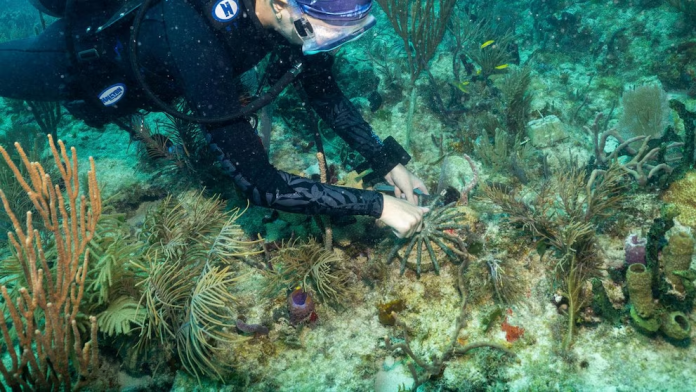A pioneering scientific consortium comprising experts from the University of Miami, the Florida Aquarium, and Honduras-based Tela Coral has undertaken a critical mission of transplanting crossbred coral fragments onto a reef near Miami ravaged by severe bleaching two years ago, according to AP News.
The scientists’ objective is to bolster reef resilience against escalating ocean temperatures driven by global warming and climate change.
Professor Andrew Baker, Director of the Coral Reef Futures Lab at the University of Miami’s Rosenstiel School, described the recent coral planting by divers as the culmination of an extensive process.
We had this idea that we really needed to try to help Florida’s coral reef by introducing more diversity from around the Caribbean, recognising that some of the biggest threats to corals, like climate change, are really global phenomena and if you try to have Florida’s reefs save themselves on their own, we could give them some outside help.
The strategy of introducing Caribbean corals matured over recent years. This approach echoes similar coral breeding initiatives, such as those in Hawaii aimed at developing heat-tolerant “super corals.”
Seeking resilience in warmer waters
The project specifically utilised fragments from a reef near Tela, Honduras, chosen because its waters are approximately 2 degrees Celsius warmer than Florida’s coastal seas. Baker’s team partnered with the Florida Aquarium and Tela Coral, spawning Honduran corals in controlled tanks.
We were able to cross the spawn from those corals, the sperm and the eggs, to produce babies. One parent from Florida, one parent from Honduras.
Elkhorn corals hold immense ecological value as iconic Florida species.
And the reef is what protects shorelines from storms and flooding. So if you have healthy Elkhorn coral populations, you have a great reef that is acting almost like a speed bump over which waves and storms pass and dissipate their energy before they hit the coast.
These corals are in sharp decline, exacerbated by the 2023 bleaching event and rising sea temperatures. Baker estimates a loss exceeding 95% of Florida’s Elkhorn populations. Bleaching occurs when prolonged warmth stresses the symbiotic algae within corals, causing them to release toxins.
The corals expel the algae, leaving a stark white skeleton and a weakened, dying organism. Keri O’Neil, Director of the Florida Aquarium’s Coral Conservation Programme, confirmed that corals spawned in their lab since 2020 are central to the effort, with more Honduran and Floridian fragments housed there.
We hope that every year in the future we can make more and more crosses and continue to figure out which parents produce the best offspring.
The newly planted hybrid Elkhorn fragments were meticulously positioned on small concrete bases along the degraded reef. The team will specifically analyse whether corals with a Honduran parent outperform purely Floridian ones. Baker called the mission the most exciting endeavour of his 20-year career.
But it’s really the future that we’re looking to and in particular, a warming future and a warming summer, how these corals do and do they have more thermal tolerance than the native Florida population, because that’s really what the goal of the whole project is.
Success could provide a vital template for broader Caribbean reef restoration. Juli Berwald, co-founder of Tela Coral, stressed that “our environment really doesn’t have closed borders, that we can work together to make things better in the world.”
And it shows that when we talk to each other, when we work together, we can really do something that might be life-changing, not just for us but for the corals and the reefs and all the animals that rely on the reefs.
